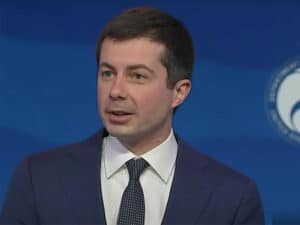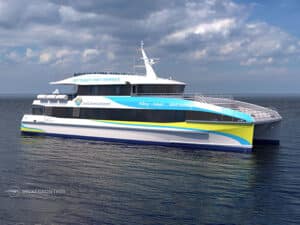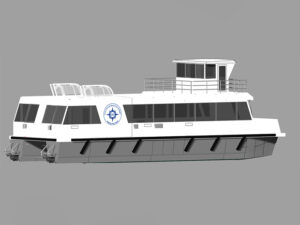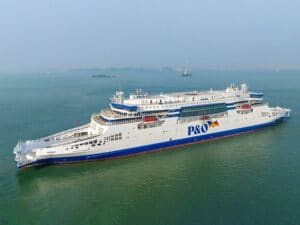
Fjord 1 names world’s largest gas-fueled ferry
Written by Nick Blenkey In a ceremony at Fiskerstrand Shipyard in Ålesund, Western Norway, ferry operator Fjord1 yesterday named the world’s largest gas-fueled ferry, MF Boknafjord, The new eco-friendly ferry, will serve the Arsvågen-Mortavika route on the Boknafjord in Rogaland County, in addition to making sure the Halhjem-Sandvikvåg route in Hordaland County now has a spare vessel.
In a ceremony at Fiskerstrand Shipyard in Ålesund, Western Norway, ferry operator Fjord1 yesterday named the world’s largest gas-fueled ferry, MF Boknafjord, The new eco-friendly ferry, will serve the Arsvågen-Mortavika route on the Boknafjord in Rogaland County, in addition to making sure the Halhjem-Sandvikvåg route in Hordaland County now has a spare vessel.
The traffic on these ferry routes has surged since Fjord1 took over as operator in January 2007, prompting the Norwegian Public Roads Administration (NPRA) to order the new ferry.
“The increase in traffic on these two ferry links alone has been much higher than our prognosis showed when we started in 2007. The lines and latency have sometimes been longer than what we would like to offer travelers. We are therefore looking forward to getting MF Boknafjord into operation, and we congratulate Fjord1 with the new build, says Øyvind Haaland, leader at the road and transport section in NPRA, Region West.
About 2,2 million cars and about five million passengers used the two ferry links in 2011. The ferry shall also serve as a spare vessel for Bjørnefjorden in case of planned maintenance downtime or any unforeseen problems. The route will then run according to the schedule in effect today.
Leif Øverland, CEO of Fjord1, says that the new ferry will reduce NOX emissions of approximately 90 per cent.
“We strive to minimise our effect on the environment around us, and are therefore encouraged by the government’s strong focus on eco-friendly forms of energy consumption in the tendering process”, says Leif Øverland, CEO of Fjord1.
Aside from being gas-powered, the ferry’s hull design and more efficient engine technology yield additional energy savings by reducing fuel consumption and methane emissions.
By changing from diesel to natural gas, virtually all emissions of particles (smoke/soot) are eliminated, as well as all emissions of sulphur. Furthermore, CO2 emissions will be reduced by as much as 25 per cent.
Fjord1 has long focused on eco-friendly transport solutions. The company, which started operating the world’s first gas ferry Glutra in Møre og Romsdal County in 2000, is a market leader in the operation of gas-powered car ferries. The ferry route serving the coastal trunk road in Rogaland and Hordaland Counties has since 2007 been served by five such ferries from Fjord1. This third ferry on the Arsvågen-Mortavika route—which will also be a substitute vessel for Halhjem-Sandvikvåg—will thus be the sixth gas ferry in this region. By the end of 2011, Fjord1 will have 12 gas ferries in operation along the Norwegian coast, making the company a world leader.
“We have an increased focus on environmental aspects in all parts of our company, and look forward to using this modern, future-oriented ferry in our transport network”, says Stig Kristoffersen, Managing Director of Fjord1 Fylkesbaatane, which operates these ferries.
About MF Boknafjord
The new, gas-operated ferry is designed by Multi Maritime AS in Førde, Western Norway and has a total length of 129.9 m, a maximum width of 19.2 m and a capacity of 242 passenger cars or 22 heavy goods vehicles in combination with passenger cars. The ferry holds 600 passengers including staff. The ferry is built according to Det Norske Veritas class and has deadweight of approx. 1,350 metric tonnes and is approx. 7500 register tonnes. The ship has four azimuth thrusters that are run by a gas-electric system consisting of three large LNG gas motors and alternators. The gas motors will give a service speed of approx. 20 knots.
The ferry has been built by Fiskerstrand BLRT AS, a Norwegian-registered joint venture company established 50/50 in 2007 by Fiskerstrand Verft AS in Ålesund and Western Shipyard in Klaipeda, Lithuania. The two shipyards have cooperated closely since 2000 and the new company is responsible for the shipyard group’s shared focus on shipbuilding and projects related to renewable energy. Fiskerstrand BLRT AS has a joint, overall responsibility for design/engineering, sales/marketing, contracting, funding, major purchases, project management, shipyard coordination and vessel handover to the client.
The new ferry’s hull and basic equipment has been manufactured at Western Baltija Shipbuilding in Klaipeda, Lithuania, and the remaining equipment manufactured, tested and finalised by Fiskerstrand Verft AS in Ålesund, Norway.
December 14, 2011





Leave a Reply
You must be logged in to post a comment.